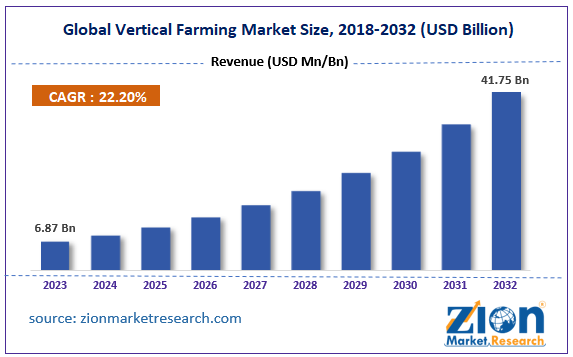Growing crops in layers, frequently in controlled indoor settings, is known as “vertical farming,” and it is a groundbreaking method of agriculture. Compared to conventional agricultural methods, this cutting-edge strategy makes better use of available land, uses less water, fewer pesticides, and produces less greenhouse gas. As people become more concerned about issues like food insecurity, environmental degradation, and overcrowding in cities, vertical farming has emerged as a promising way to provide the rising demand for fresh vegetables. This study sheds light on the vertical farming market’s transformational potential and future prognosis by diving into its growth, size, share, trends, and forecast up to 2032.
Market Growth and Size:
Predictions show that the global vertical farming market would expand from an estimated 6.87 billion USD in 2023 to over 41.75 billion USD in 2032, a CAGR (compound annual growth rate) of about 22.2% from 2024 to 2032.

Rising populations, more urban areas, changing weather patterns, and innovative agricultural technologies have all contributed to the explosive expansion of the vertical farming industry in recent years. Modern statistics show that commercial growers, urban farmers, and agricultural entrepreneurs all around the globe are increasingly turning to vertical farming systems, which has led to a sizable demand for these products. You can find hydroponic, aeroponic, and aquaponic systems in large-scale commercial farms, as well as smaller-scale vertical farming enterprises in urban warehouses.
Market Share and Trends:
- Expansion of Urban Agriculture: The demand for fresh, locally grown produce has skyrocketed in urban areas due to megacities and urbanization. Urban agriculture is made possible through vertical farming, which brings the production of fruits, vegetables, and herbs closer to the consumers by exploiting underused locations like rooftops, abandoned buildings, and industrial sites. By cutting down on food miles and carbon emissions, vertical farms help lessen the environmental toll of food distribution and transportation.
- Technological Innovations: Vertical farming techniques, automation, and improved methods of crop management are all being propelled forward by new technological developments. To keep tabs on the weather, maximize resource use, and forecast harvests, vertical farms use sensors, internet of things (IoT) systems, artificial intelligence (AI), and data analytics. The use of automated technologies for planting seeds, watering plants, delivering nutrients, and harvesting crops greatly improves the efficiency and effectiveness of farming operations.
- Diversification of Crops: The vertical farming market is witnessing a diversification of crops beyond leafy greens and herbs to include a wide range of fruits, vegetables, and specialty crops. Advances in lighting technology, climate control, and cultivation techniques enable the successful cultivation of tomatoes, strawberries, peppers, cucumbers, and even root vegetables in vertical farming systems. This diversification expands market opportunities and enhances the nutritional diversity of vertical farm produce.
- Sustainability and Environmental Impact: Sustainability is a key focus area for the vertical farming industry, with an emphasis on resource efficiency, water conservation, and renewable energy integration. Vertical farms utilize recirculating hydroponic and aeroponic systems that consume significantly less water compared to traditional soil-based agriculture. Renewable energy sources such as solar panels, wind turbines, and cogeneration systems power vertical farming facilities, reducing reliance on fossil fuels and minimizing greenhouse gas emissions.
Forecast for 2032:
The vertical farming market is poised for continued growth and innovation in the next decade, driven by:
- Increasing adoption of vertical farming technologies in urban and peri-urban areas.
- Advancements in crop genetics, plant breeding, and biotechnology for vertical farming.
- Expansion of vertical farming networks and collaborations between growers, technology providers, and food retailers.
- Government initiatives and incentives to promote sustainable agriculture, food security, and urban greening.
- Consumer demand for locally grown, pesticide-free, and sustainably produced fruits and vegetables.
Conclusion:
In conclusion, the vertical farming market represents a disruptive force in modern agriculture, offering sustainable solutions to address food security challenges, mitigate environmental impact, and promote urban resilience. By embracing technological innovations, fostering industry partnerships, and advocating for supportive policies, stakeholders in the vertical farming market can drive continued growth, innovation, and positive impact on global food systems in the years leading up to 2030.

